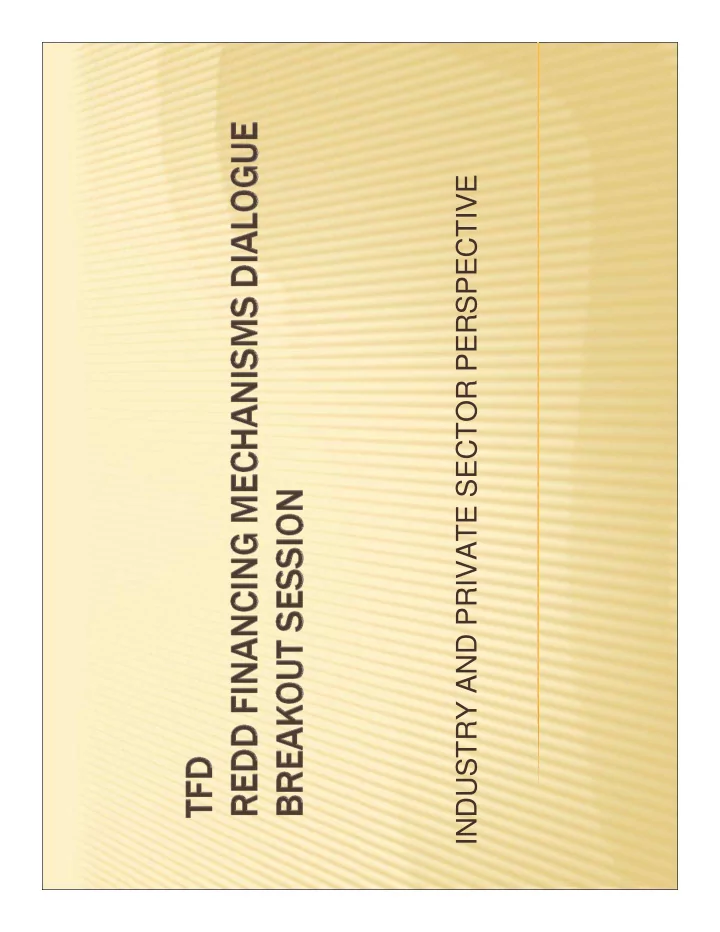

INDUSTRY AND PRIVATE SECTOR PERSPECTIVE
� Investors � Global Forest Partners - TIMO � EcoSecurities - Carbon market maker � Forestry + Forest products manufacturers � KCC – consumer products � MWV – forestry & packaging � Business NGO � WBCSD – sustainable development � Stella Schons, Yale F&ES
� Grants � Loans • Flexible system (no “one size � Investment fits all) � Trade • Adaptable • Phased approach • Payment for services requires accountability • Non-complex and clear (learn from CDM projects) • Discounting is the primary market mechanisms that deals with variation in risks
� Objective: making sure that the negotiators are aware of the value of forests and the role they play and develop a mechanism to include that value. � What are the boundary issues? � Forestry vs. energy vs. scientific vs. development (education, health, etc.) interventions. � Can/should REDD finance all these?? � Are there ways of embedding these other objectives within capacity building grants?
� REDD mechanisms should support the widest possible range of SFM actions: � From Avoided Deforestation to SM of primary forests to enrichment planting/rehabilitation/plantations, AR � End game is = changing patterns of land use to deliver on carbon reductions but deliver other co- benefits � Credible: MRV (monitoring, reporting and independent verification) = leverage forest certification underpinning the market instead of recreating things = carbon certification
� Phase approach recognizing there will be different approaches for different regions and that different regions will change or graduate over time � Grants and loans (soft/hard) to build capacity = REDD readiness � Commercial investments and trade capital to follow once capacity in place
� Revenue raising and dispersion tied to the ways “money moves” � Who takes what level of risk? Ability to manage and absorb risk will dictate the type of flow Return on Capacity Building: � Grant: countries with minimal capacity to bring in larger scale project finance (capacity building around science, institutions, governance etc.) � Soft loans Return on Investment (sharing of benefits going forward): � Hard Loans � Investment � Trade
� Conditionality surrounding targeted areas will be required by the market. But also… � Transparency: clear definition of who is the buyer and seller, who owns the tons of carbon, who manages the carbon risk etc. � Transparency + Governance = predictability
� Consider return of investment of governments – may be more effective for governments to invest in their own development than wait for ODA support flows � Role of governments (providing guarantee), insurance (if I do not deliver someone pays) and policy (require to buffer – pooling of projects) in managing the risks
� Clear buyer and clear seller: short distribution chains � Funding rules � Property rights: transparency � Tenure rights: rule of law � Carbon rights: capacity to deliver � Public policy approaches should leverage learnings of the voluntary market e.g. VCS, CCBA, pooling, insurance, risk spreading)
� No premiums � Less discounting � Governments making their own assessments of what their priorities are and set the rules to address co-benefits � Investments can also deliver co-benefits: social contract conditions need to be considered
� Effective engagement on the ground � Effective in-country arbitrator/tribunal (need to “define” involved stakeholders) � Code-of-conduct on stakeholder engagement (FSC/ISO/WB???) � Effective participation � Obligation � Affected stakeholders � Avoid legacy problems (stranded investment) • Who pays?
� Data gathering (going back to stakeholder engagement): few countries ready to have projects without having enormous discounting � ODA, government internal investment: � Better stakeholder engagement � Build the science � Ongoing monitoring, and � Establishment of rules � Internal sharing of benefits macro/micro � Leverage lessons learned from the existing structures: e.g. voluntary markets and certification – need to leverage processes
� Trying to max change of flows or monitoring of stocks? � Keep carbon in context: carbon is only one of the values � Other values: products, biodiversity, water, etc., many of which will never be fungible…but can be delivered via SFM
Recommend
More recommend